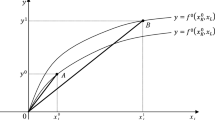Abstract.
In light of the textile industry's growing foreign competition, trade deficit and job loss, we estimate its productivity and efficiency for the period 1975–93 utilizing a variable elasticity of substitution production function. The results indicate that, despite job losses, the industry adjusted by increasing labor productivity and maintaining fairly stable profits. This performance does not warrant protectionist policies. However, with an elasticity of factor substitution less than one and decreasing, the impact of factor price increases could result in higher apparel prices and preference for cheaper imports. Furthermore, with an elasticity of capital output rapidly decreasing, significant technological improvements will be required to improve competitiveness since textile production is capital intensive. Recently revised rules on trade liberalization could increase competition in the industry.
Similar content being viewed by others
Author information
Authors and Affiliations
Additional information
First version received: October 1999/Final version received: August 2000
Rights and permissions
About this article
Cite this article
Ramcharran, H. Estimating productivity and returns to scale in the US textile industry. Empirical Economics 26, 515–524 (2001). https://doi.org/10.1007/s001810000068
Issue Date:
DOI: https://doi.org/10.1007/s001810000068




